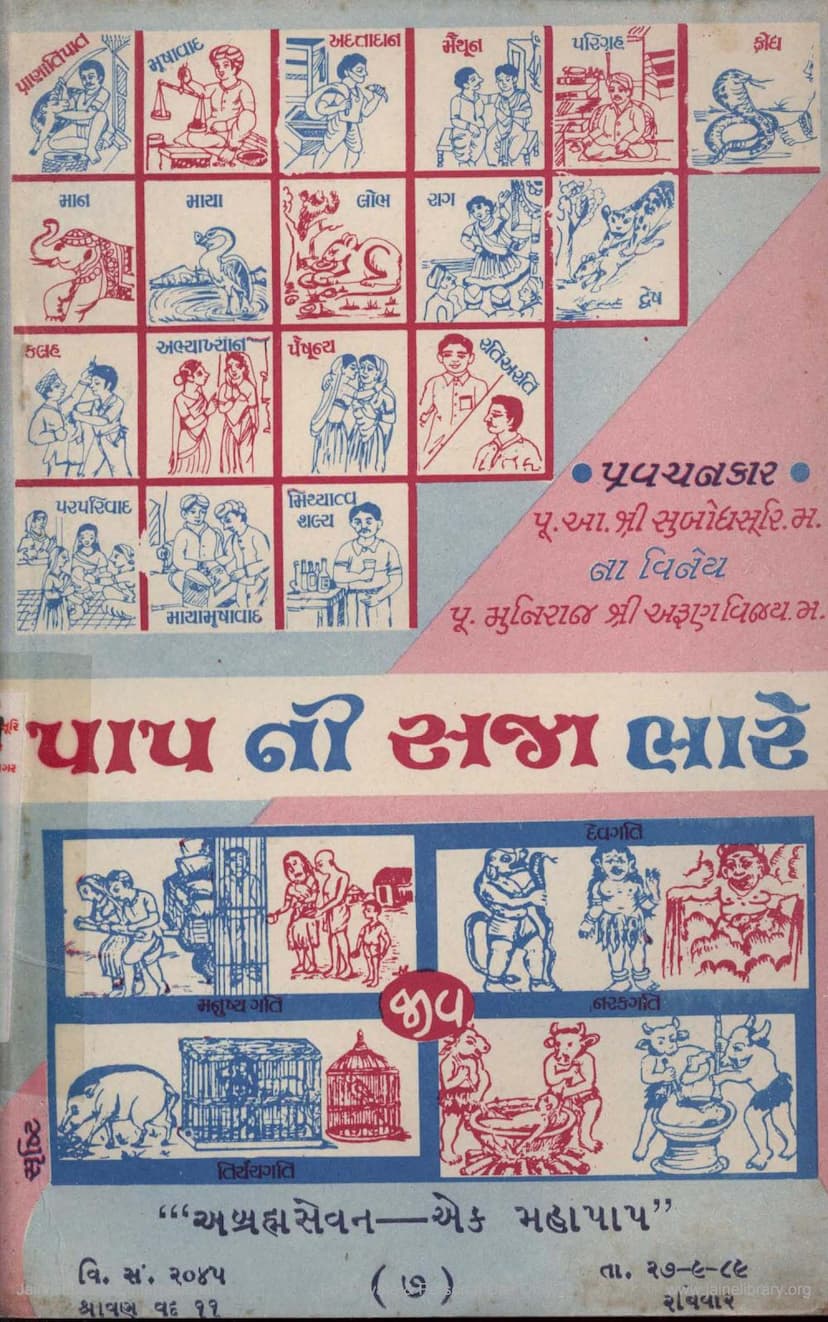Papni Saja Bhare Part 07
Added to library: September 2, 2025

Summary
Here's a comprehensive summary of the provided Jain text, "Papni Saja Bhare Part 07," focusing on the central theme of "Abrahmasevan - Ek Mahapap" (Unchastity - A Great Sin), presented in English:
Book Title: Papni Saja Bhare Part 07 Author: Arunvijaymuni Publisher: Dharmanath Po He Jainnagar Swe Mu Jain Sangh
This booklet, the seventh in the series "Papni Saja Bhare" (The Consequences of Sins), delves deeply into the concept of Abrahmasevan (unchastity or lack of celibacy), highlighting it as a "Maha Pap" (Great Sin) within Jain philosophy. The text is based on discourses by Pujya Acharya Shri Subodhsuriishwarji Maharaj Saheb and the author, Pujya Muniraj Shri Arunvijayji Maharaj.
Core Message: The central thesis of the book is that Brahmacharya (celibacy or pure conduct) is fundamentally about being absorbed in the self, in the spiritual essence. Unchastity, or Brahmasevan, is presented as the root of many vices and a significant obstacle to spiritual progress. The text explores the pervasive nature of desire and its impact on the soul across various life forms and celestial realms.
Key Concepts and Themes:
- The True Meaning of Brahmacharya: It's not just the absence of sexual activity but a state of being immersed in one's own soul (Atman) and its infinite knowledge and perception. The root "char" in Brahmacharya signifies movement or absorption in the self.
- The Influence of Karmas: The book explains how attachment to the physical body and sensory pleasures leads to the accumulation of karmas, particularly Mohaniya Karma (delusion-inducing karma). This karma obscures the soul's inherent qualities, like infinite character (Anant Charitra) and right belief (Samyak Darshan).
- The Nature of Mohaniya Karma: This karma is divided into Darshan Mohaniya (obscuring right belief) and Charitra Mohaniya (obscuring right conduct). Charitra Mohaniya is further broken down into Kashaya Mohaniya (anger, pride, delusion, greed) and Nekaṣāya Mohaniya (related to passions like laughter, pride, shame, fear, disgust, etc.).
- Ved Mohaniya (Passion of Sensual Desire): A significant portion of the text focuses on "Ved," which, in this context, refers to sensual desire, lust, and attraction. The three types of Ved are:
- Stree Ved (Feminine Passion): Creates desire for union with males.
- Purush Ved (Masculine Passion): Creates desire for union with females.
- Napunsak Ved (Neuter Passion): Creates desire for union with both males and females. The text details how these are present in various life forms, from one-sensed beings to humans and celestial beings.
- Abrahmasevan Across Life Forms: The book illustrates the prevalence of unchastity and sensual desire in various realms:
- Tiryan Gati (Animal Realm): Examples of insects, animals, and birds engaging in mating are given, often without the discrimination seen in humans. Disturbingly, instances of incest among animals are highlighted to show the power of unbridled desire.
- Manushya Gati (Human Realm): It emphasizes the intense passions in humans, leading to various forms of sensual engagement.
- Dev Gati (Celestial Realms): Even celestial beings are not entirely free from sensual desires, though the nature of their engagement and the intensity of passion vary according to their realm. While some engage in physical union, higher celestial beings experience desire more mentally.
- The Destructive Nature of Unchastity: The text uses powerful analogies (like fire consuming fuel) to illustrate how the pursuit of sensory pleasures never leads to satisfaction but rather intensifies desire and leads to suffering. It describes the physical and mental deterioration caused by excessive indulgence, leading to weakness, diseases, and ultimately, rebirth in lower realms.
- The Importance of Restraint: For lay followers (Shravakas and Shravikas), the text discusses the path of limited vows (Desh Virati) and emphasizes restraint in sensual matters, starting with contentment in one's own spouse and observing periods of celibacy.
- Examples of Great Souls: The book recounts the lives of exemplary figures who practiced strict celibacy and self-control, such as Vijay Sheth and Vijayā Shethani, and the immense spiritual benefits derived from such practices. It also mentions the transformative journeys of individuals like Thulibhadra and others who overcame intense desires through spiritual discipline.
- Modern Challenges: The text criticizes modern societal trends that promote immodesty, the influence of media, and the erosion of traditional values, which contribute to the rise of unchastity and its negative consequences. It highlights the corrupting influence of co-education, immodest fashion, and the breakdown of family structures.
- The Role of Education and Upbringing: The book laments the lack of spiritual guidance in modern education and family life, which leaves young minds vulnerable to the temptations of sensual desires.
- The Consequences of Unchastity: The text vividly describes the severe karmic consequences, including suffering in hellish realms, rebirth in lower forms of life, and the inability to attain spiritual liberation.
- The Goal of Moksha: Ultimately, the text points towards the Jain path of renunciation and spiritual discipline as the means to overcome these desires and achieve Moksha (liberation).
Call to Action: The booklet serves as a profound warning against the perils of unchastity and a strong encouragement for readers to embrace Brahmacharya in its various forms, according to their capabilities, to purify their lives and achieve spiritual well-being. It emphasizes that true happiness and liberation lie in conquering desires, not in their pursuit.